Quality Control of Electro-Discharge Texturing of Rolls Through Six Sigma
Abstract
1. Introduction
2. Materials and Methods
- On the EDT 2100/4500 device, it is possible to repeatedly create a texture on the surface of rolls with roughness Ra in the range from 1.5 μm to 3.8 μm and with peak density Pc > 40 cm−1.
3. Results and Discussion
- CL, the central line, or the target value (CL ≈ TV) of the regulated roughness characteristic.
- UCL, the upper control limit, is calculated from the range of variation (VR) of the regulated quality indicator (UCL = CL + VR/2). If the measured values are above the UCL, the process is not stable.
- LCL, the lower control limit, is calculated from the VR range of the regulated quality indicator (UCL = CL − VR/2). If the measured values are below the LCL, the process is not stable.
- UWL, the upper warning limit, is calculated from twice the VR (UWL = CL + 2.VR/6).
- LWL, the lower warning limit, is calculated from twice the VR (UWL = CL − 2.VR/6).
- USL, the upper safe limit, is calculated from a multiple of the VR (USL = CL + VR/6).
- LSL, the lower safe limit, is calculated from a multiple of the VR (USL = CL − VR/6).
- 1. Step: defining the target values of quality characteristics TVRa and TVPc.
- 2. Step: Assignment of input parameters of the EDT process (Ip, Up, Ton, and Toff) to defined target values TVRa and TVPc according to Formulas (30)–(33):
- 3. Step: Calculation of the values of qualitative characteristics YQRa and YQPc according to Formulas (25) and (28), calculation of ∆Ra and ∆Pc according to Formulas (27) and (29), and calculation of indices CpkL and CpkU according to Formulas (10) and (11). Thus, for Cpk ≥ 1.33, the standard deviation after adjustment of the equations is
- 4. Step: Comparison of calculated values of CpkRa and CpkPC with the limit value 1. If the calculated values of CpkRa and CpkPc are less than 1, the process is not capable, and it is necessary to adjust the input parameters.
- 5. Step: If the calculated values of CpkRa and CpkPC are in the interval from 1 to 1.33, the process is capable, but the compliance rate is low, so it is recommended to take measures to improve the stability of the process.
- 6. Step: If the calculated CpkRa and CpkPC values are greater than 1.33, the compliance rate is high, and no process improvement measures need to be taken.
- 7. Step: Printing of output parameters of the quality characteristics Ra, Pc, and the input parameters of the EDT process Ip, Up, Ton, and Toff.
4. Conclusions
- On the basis of control diagrams, Cpk capability indices, and Z scores, it is possible to take measures to improve the quality characteristics Ra and Pc of the surface textures of the rolls in rolling mills.
- The results obtained by means of regression analysis indicate that the roughness Ra created during EDT is strongly dependent on the discharge energy. The coefficient of determination R2 reached values greater than 0.99.
- The parameters Ip, Up, and Ton of the EDT process have a major influence on the roughness Ra. An increase in these parameters of the texturing process leads to an increase in Ra values.
- Using regression analysis, the dependences of Ra on Ip were described by a logarithmic regression equation, and the dependences of Ra on both Up and Ton were described by linear regression equations. The regression models showed a strong correlation (R2 > 0.9).
- Using the obtained dependencies, a purpose function was created and verified. This function allows one to predict the roughness Ra with an accuracy of ± 0.02 μm in the analyzed interval of texturing parameters Ip, Up, and Ton.
- The regression equation of the dependence of the peak density Pc on Toff was used to predict the peak density. The R2 coefficient was greater than 0.98.
- Based on the comparison of the conformity of the Cpk capability indices with the limit values, an algorithm was designed, which allows step-by-step decisions to be made to improve the EDT process of rolling mill rolls.
Author Contributions
Funding
Data Availability Statement
Acknowledgments
Conflicts of Interest
References
- Sakuramoto, C. Automotive Skin Panels Quality Improvement by Means of Finite Element Method. In Proceedings of the Conference SAE Commercial Vehicle Engineering Congress (COMVEC), Rosemont, IL, USA, 1–3 October 2013. [Google Scholar] [CrossRef]
- Schulte, C.; Li, X.; Abel, D.; Hirt, G. Model-based Control of the Strip Roughness in Cold Rolling. FAC Pap. 2021, 54, 109–114. [Google Scholar] [CrossRef]
- Çolak, B.; Zahoor, A.; Özakin, B.; Kurgan, N. An Experimental Investigation into Roughness Transfer in Asymmetrical Rolling of Steel Strips. Karadeniz Fen Bilim. Derg. 2023, 13, 1070–1089. [Google Scholar] [CrossRef]
- Çolak, B.; Kurgan, N. An experimental investigation into roughness transfer in skin-pass rolling of steel strips. Int. J. Adv. Manuf. Technol. 2018, 96, 3321–3330. [Google Scholar] [CrossRef]
- Cavallari, M.; Gaboardi, P.; McWhirter, R.; Perassolo, M.; Trevisan, C. New Surface Finishes for Cold Rolling Mills. In Proceedings of the METEC & 2nd ESTAD 2015, European Steel Technology and Application Days, Düsseldorf, Germany, 15–19 June 2015. [Google Scholar]
- Elkoca, O. A study on the characteristics of electrical discharge textured skin pass mill work roll. Surf. Coat. Technol. 2008, 202, 2765–2774. [Google Scholar] [CrossRef]
- Rodriguez-Vidal, E.; Matthews, D.T.A.; de Viteri, V.S.; Korver, F.; Wentink, D.J.; Quintana, I. Surface design and texturing of strip steel using nanosecond pulsed lasers for simulated roughness transfer and paint appearance. J. Mater. Process. Technol. 2020, 275, 116365. [Google Scholar] [CrossRef]
- Evin, E.; Tomáš, M.; Kmec, J. Optimization of Electro-Discharge Texturing Parameters for Steel Sheets’ Finishing Rollers. Materials 2020, 13, 1223. [Google Scholar] [CrossRef]
- Bartkowiak, T.; Mendak, M.; Mrozek, K.; Wieczorowski, M. Analysis of Surface Microgeometry Created by Electric Discharge Machining. Materials 2020, 13, 3830. [Google Scholar] [CrossRef] [PubMed]
- Nieslony, P.; Wojciechowski, S.; Gupta, M.K.; Chudy, R.; Krolczyk, J.B.; Maruda, R.; Krolczyk, G.M. Relationship between energy consumption and surface integrity aspects in electrical discharge machining of hot work die steel. Sustain. Mater. Technol. 2023, 36, e00623. [Google Scholar] [CrossRef]
- Hourmand, M.; Farahany, S.; Sarhan, A.A.D.; Noordin, M.Y. Investigating the electrical discharge machining (EDM) parameter effects on Al-mg 2 Si metal matrix composite (MMC) for high material removal rate (MRR) and less EWR–RSM approach. Int. J. Adv. Manuf. Technol. 2015, 77, 831–838. [Google Scholar] [CrossRef]
- Straka, Ľ.; Piteľ, J.; Čorný, I. Influence of the main technological parameters and material properties of the workpiece on the geometrical accuracy of the machined surface at wedm. Int. J. Adv. Manuf. Technol. 2021, 115, 3065–3087. [Google Scholar] [CrossRef]
- Bidulska, J.; Kvackaj, T.; Bodak, V.; Bidulsky, R. The Microgeometry Parameters of Uncoated and Zinc-Coated Cold Rolled Steel Strips. J. Met. Mater. Miner. 2007, 17, 1–7. [Google Scholar]
- Çolak, B.; Kurgan, N. EDT ve Sbt Yöntemleriyle Pürüzlendirilmiş Soğuk Hadde Merdanelerinin Yüzey Pürüzlülük Etkilerinin Karşılaştırılmasına Dair Bir Çalışma. In Proceedings of the 1st International Iron and Steel Symposium (IISS′12), Karabuk, Turkey, 2–4 April 2012; Karabuk University: Karabuk, Turkey, 2012; p. 861. [Google Scholar]
- Gorbunov, A.V.; Belov, V.K.; Begletsov, D.O. Texturing of Rollers for the Production of Auto-Industry Sheet. Steel Transl. 2009, 39, 696–699. [Google Scholar] [CrossRef]
- Simao, J.D.; Aspinwall, K.; Wise, M.L.H.; El-Menshawy, M.F. Electrical discharge texturing of cold mill work rolls using different tool electrode materials. Iron Steel Eng. 1996, 73, 42–47. [Google Scholar]
- Colak, B.; Basoglu, F.; Kurgan, N. Texturing methods for cold mill work rolls. In Proceedings of the Fourth International Iron and Steel Symposium, Karabuk, Turkey, 4–6 April 2019; pp. 424–431. [Google Scholar]
- Świercz, R.; Holubek, R. Experimental investigation of influence electrical discharge energy on the surface layer properties after EDM. Weld. Technol. Rev. 2020, 92, 7–13. [Google Scholar] [CrossRef]
- Munro, R.A.; Ramu, G.; Zrymiak, D.J. The Certified Six Sigma Green Belt Handbook, 2nd ed.; Quality Press: Welshpool, Australia, 2015. [Google Scholar]
- Giampieri, A. A review of the current automotive manufacturing practice from an energy perspective. Appl. Energy 2020, 261, 114074. [Google Scholar] [CrossRef]
- Coleman, S. Six Sigma: An opportunity for statistics and for statisticians. Significance 2008, 5, 94–96. [Google Scholar] [CrossRef]
- Tyzdek, T.; Keller, P.A. The Six Sigma Handbook, 3rd ed.; The McGraw-Hill Companies: New York, NY, USA, 2010. [Google Scholar]
- Schindlerova, V.; Marcik, J.; Čada, R.; Sajdlerova, I. Analysis of Non-Conforming Production in an Engineering Company. Tech. Gaz. 2024, 31, 296–302. [Google Scholar] [CrossRef]
- Mittal, A.; Gupta, P.; Kumar, V.; Ali Al Owad, A.; Mahlawat, S.; Sumanjeet Singh, S. The performance improvement analysis using Six Sigma DMAIC methodology: A case study on Indian manufacturing company. Heliyon 2023, 9, e14625. [Google Scholar] [CrossRef]
- Gijoa, E.V.; Scaria, J.; Antony, J. Application of Six Sigma Methodology to Reduce Defects of a Grinding Process. Qual. Reliab. Eng. Int. 2011, 27, 1221–1234. [Google Scholar] [CrossRef]
- Ganguly, K. Improvement process for rolling mill through the DMAIC six sigma approach. Int. J. Qual. Res. 2012, 6, 221–231. [Google Scholar]
- Laddha, S.A.; Desai, G. Quality improvement in building construction using six sigma. Int. Res. J. Eng. Technol. 2019, 6, 7711–7713. [Google Scholar]
- Terpák, L.; Dorčák, J.; Revaj, J. Quality Control of the Electro-Discharge Texturing. Metalurgija 2010, 49, 19–22. [Google Scholar]
- DIN EN ISO 4288; Geometrical Product Specifications (GPS)—Surface Texture: Profile Method—Rules and Procedures for the Assessment of Surface Texture. International Organization for Standardization (ISO): Geneva, Switzerland, 2009.
- Červeňanská, Z.; Važan, P.; Juhás, M.; Juhásová, B. Multi-Criteria Optimization in Operations Scheduling Applying Selected Priority Rules. Appl. Sci. 2021, 11, 2783. [Google Scholar] [CrossRef]
- Kundracik, V. Strip surface microgeometry for automotive surface car-body parts. Galvanized material for automotive industry. In Proceedings of the 66th Workshop of the STEEL STRIP Company, Košice-Jahodná, Slovakia, 12–14 October 2009; pp. 28–33. (In Slovak). [Google Scholar]
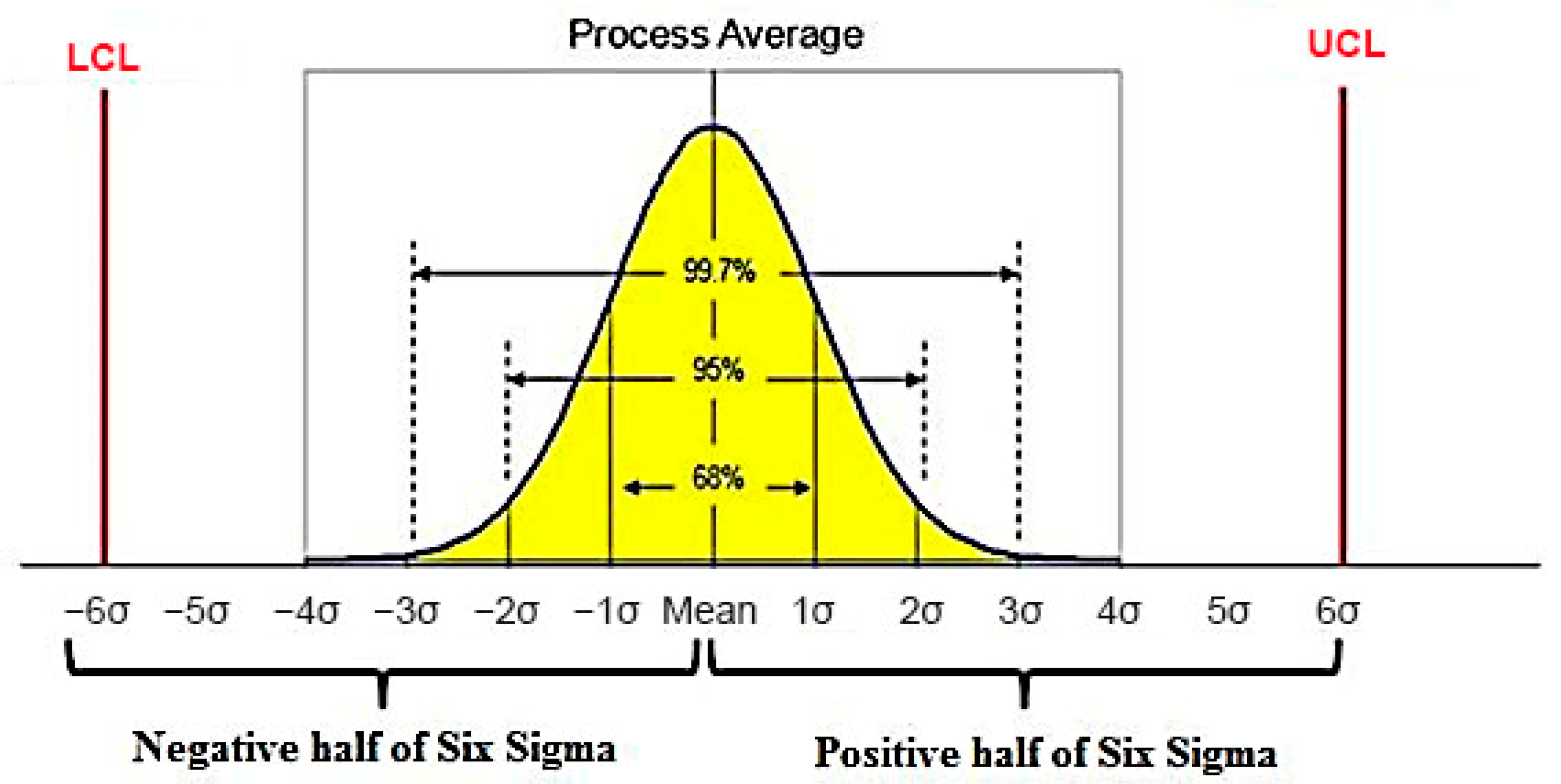

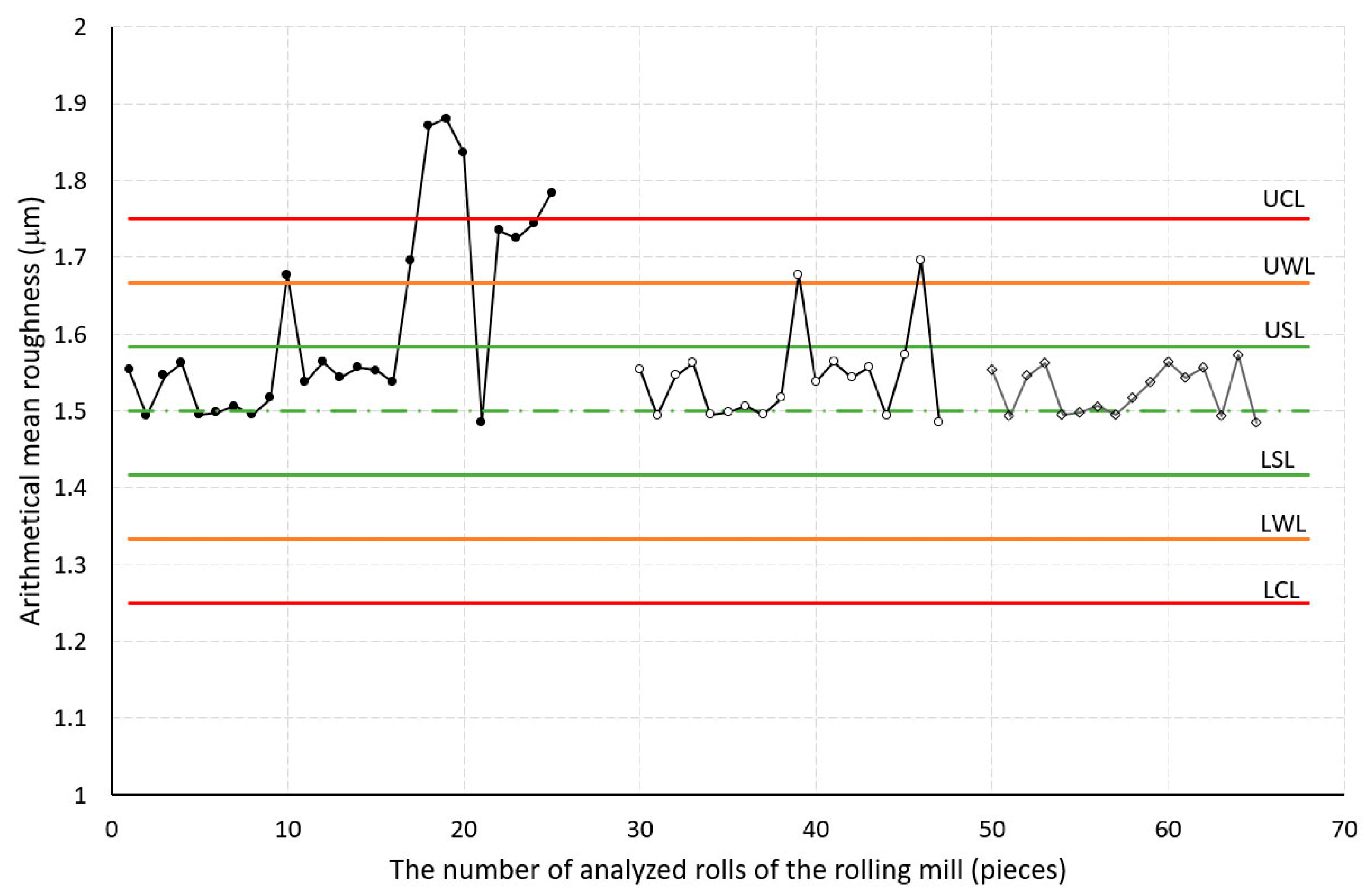


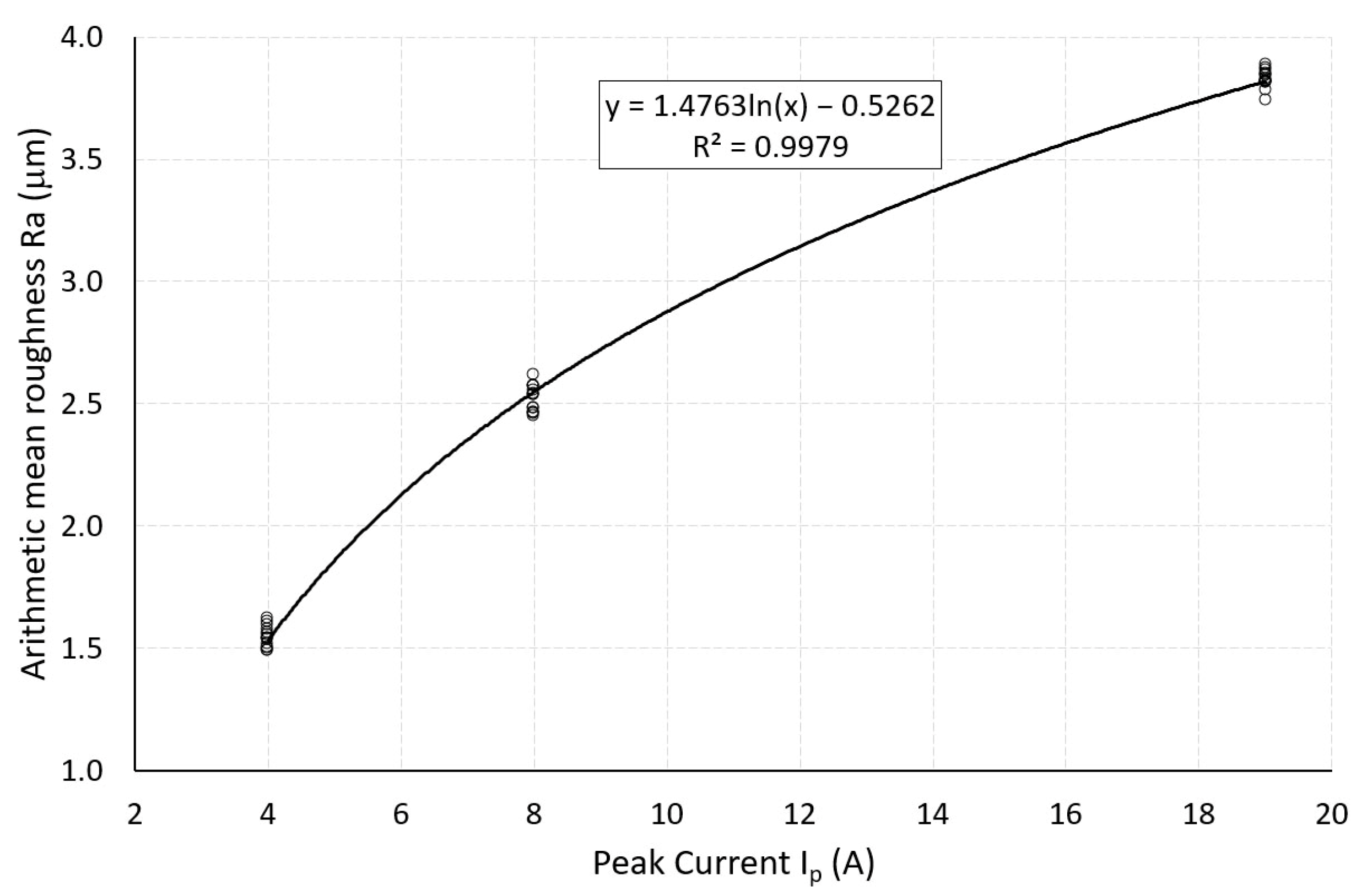
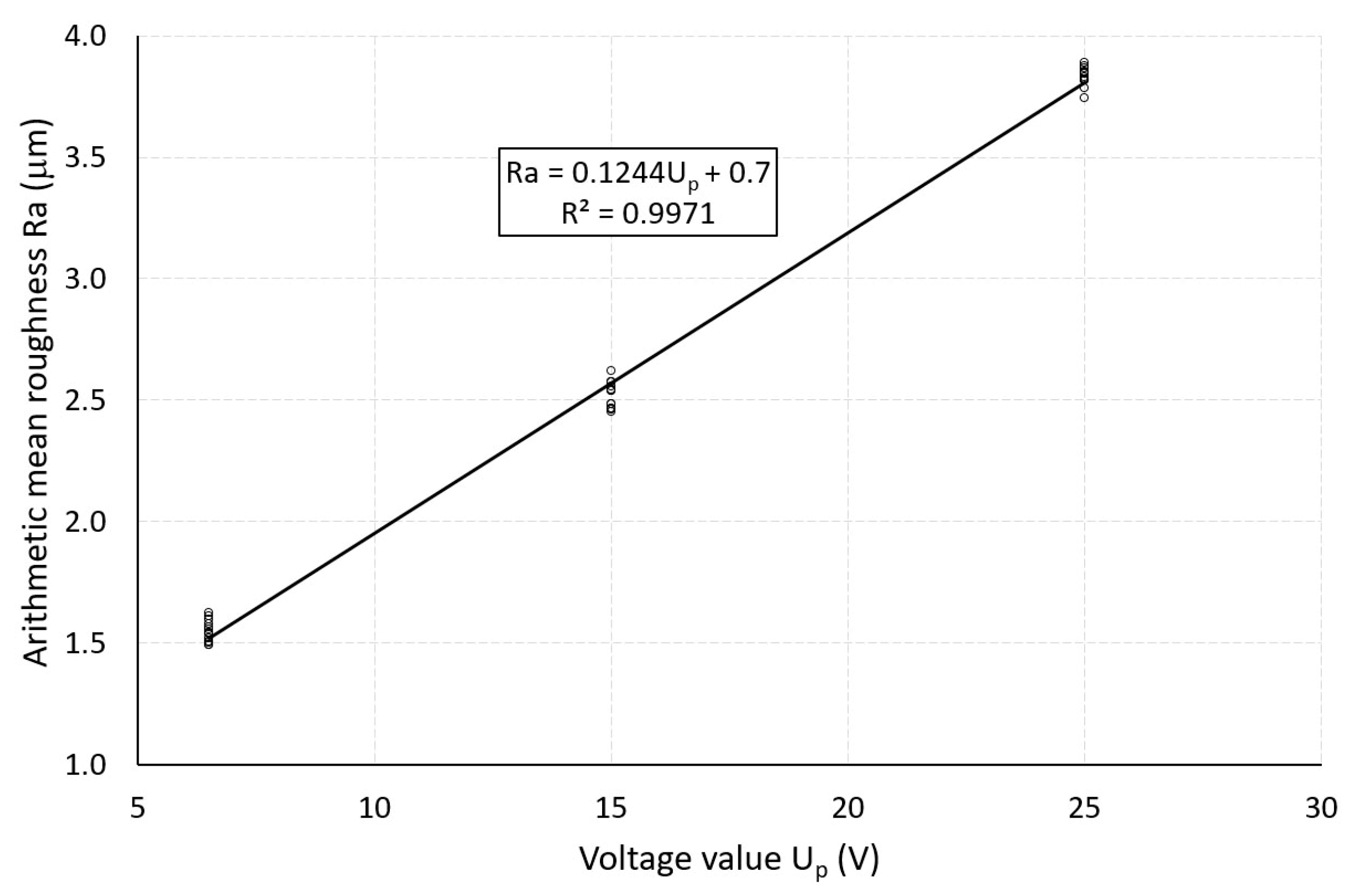


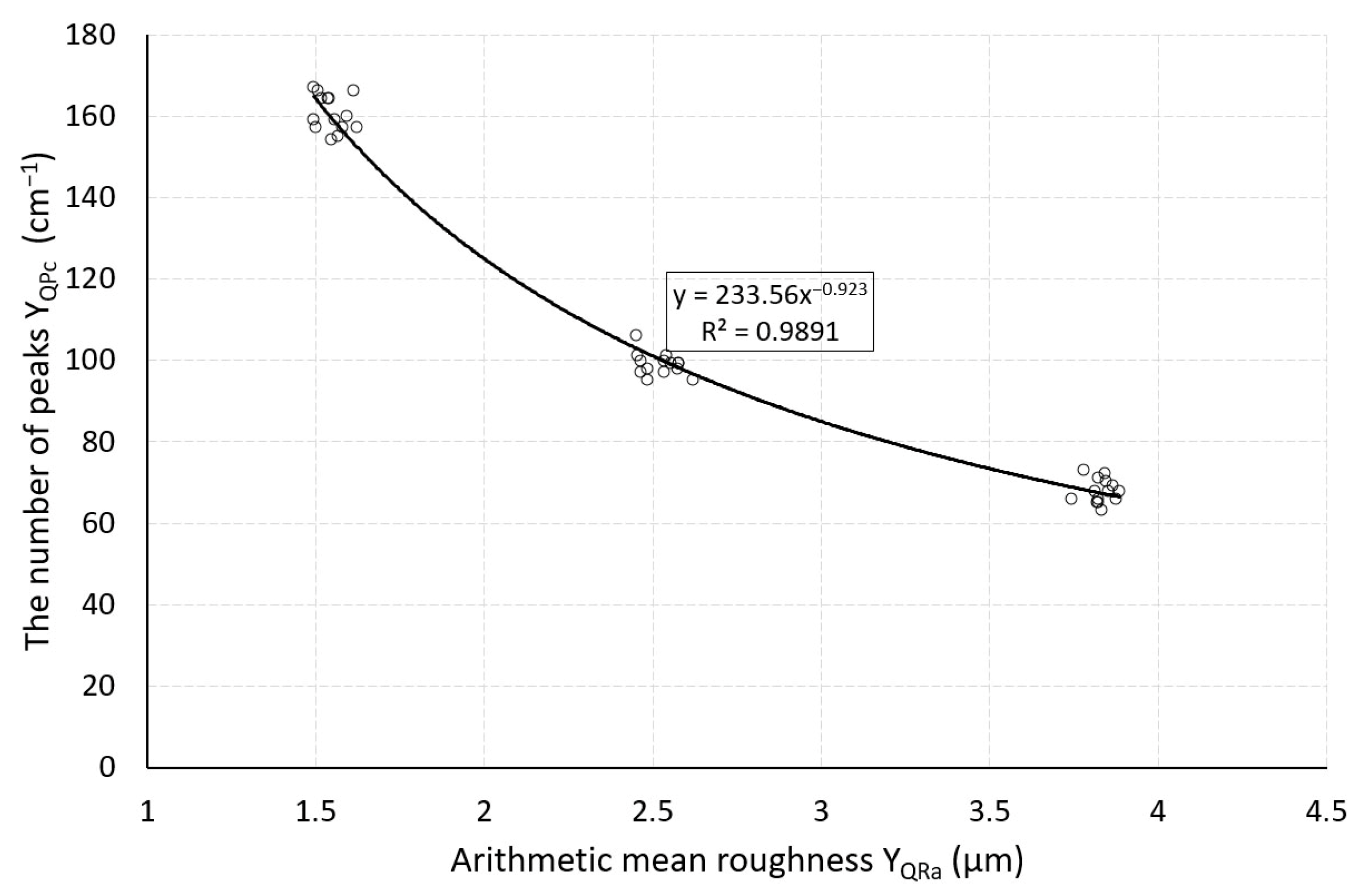
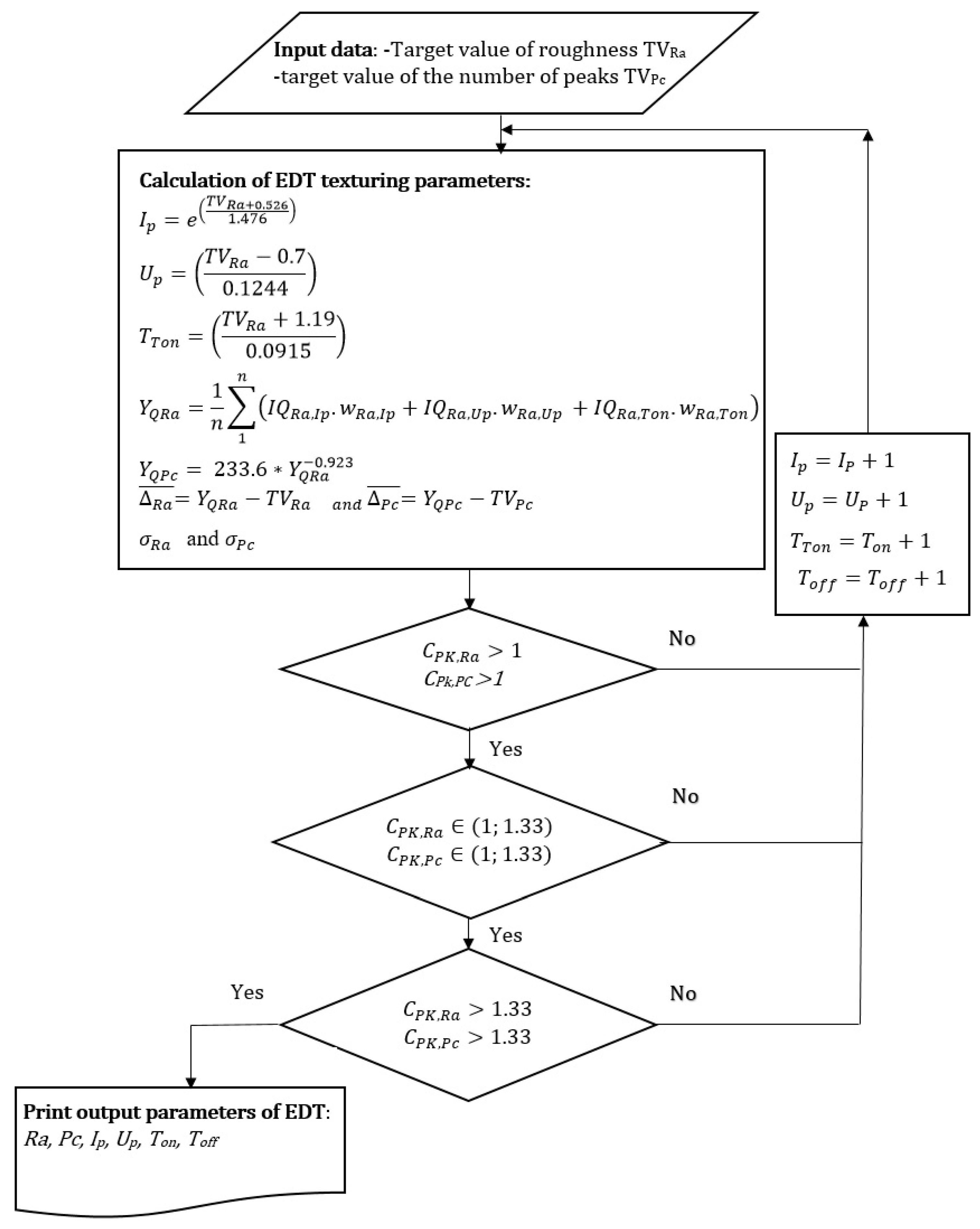
| Capability Index Cpk min | 1 | 1.13 | 1.33 | 1.49 | 1.667 | 1.75 | 1.83 | 2 |
|---|---|---|---|---|---|---|---|---|
| Six Sigma level (Zmin score) | 3 | 3.39 | 4 | 4.5 | 5 | 5.25 | 5.5 | 6 |
| DPMO | 660,807 | 30,396 | 6210 | 1350 | 233 | 88 | 32 | 3 |
| Cost of poor quality COPQ | 25% to 45% | 15% to 25% | 5% to 15% | |||||
| PE 1 TRa1 = 1.5 (μm) | PE 2 TRa2 = 2.5 (μm) | PE 3 TRa3 = 3.8 (μm) | |
|---|---|---|---|
| Texture current Ip (A) | 4 | 18 | 19 |
| Lower voltage limit UPL (V) | 5 | 10 | 15 |
| Upper voltage limit UPH (V) | 8 | 20 | 25 |
| Pulse duration Ton (μs) | 4 | 14 | 29 |
| Technological break duration Toff (μs) | 6 | 16 | 38 |
| Electrode diameter d (mm) | 8 | 8 | 8 |
| Measure Value | PE 1 | PE 2 | PE 3 | |||
|---|---|---|---|---|---|---|
| Ra (μm) | Pc (cm−1) | Ra (μm) | Pc (cm−1) | Ra (μm) | Pc (cm−1) | |
| Average value | 1.548 | 161 | 2.5 | 99 | 3.845 | 68 |
| Standard deviation SD | 0.06 | 7 | 0.06 | 3 | 0.04 | 3 |
| Upper-level Six Sigma ZU | 3.38 | - | 4.49 | - | 2.25 | - |
| Lower-level Six Sigma ZL | 4.98 | 18.6 | 4.48 | 21.1 | 7.53 | 10.0 |
| CpKU | 1.13 | - | 1.50 | - | 1.75 | - |
| CpKL | 1.66 | 6.2 | 1.49 | 7.05 | 2.51 | - |
| DPMO | 30,396 | 0 | 1350 | 0 | 88 | 3.36 |
| Measure Value | PE 1 | PE 2 | PE 3 | |||
|---|---|---|---|---|---|---|
| Ra (μm) | Pc (cm−1) | Ra (μm) | Pc (cm−1) | Ra (μm) | Pc (cm−1) | |
| Average value | 1.526 | 158 | 2.495 | 99 | 3.83 | 68 |
| Standard deviation SD | 0.03 | 7 | 0.05 | 3 | 0.02 | 3 |
| Upper-level Six Sigma ZU | 7.19 | - | 4.73 | - | 10.0 | - |
| Lower-level Six Sigma ZL | 8.88 | 18.1 | 4.56 | 21.1 | 12.91 | 9.59 |
| CpKU | 2.40 | - | 1.58 | - | 3.34 | - |
| CpKL | 2.96 | 6.0 | 1.52 | 7.05 | 4.31 | 3.20 |
| DPMO | 0 | 0 | 1350 | 0 | 0 | 0 |
| Input Data | Calculated Data | ||||||||
|---|---|---|---|---|---|---|---|---|---|
Plan | IP (A) | UP (V) | Ton (μs) | TVRa (μm) | YQRa (μm) | ΔRa (μm) | S.D.Ra (μm) | Cpk (μm) | DPMO (Pieces) |
| PE 1 | 4 | 6.5 | 4 | 1.5 | 1.514 | 0.014 | 1.311 | ≈6200 | |
| PE 2 | 8 | 15 | 14 | 2.5 | 2.511 | 0.011 | 0.06 | 1.325 | ≈6200 |
| PE 3 | 19 | 25 | 29 | 3.8 | 3.806 | 0.006 | 1.355 | ≈4300 | |
| After improvement Ton-1 | |||||||||
| PE 1 | 4 | 6.5 | 3 | 1.5 | 1.484 | −0.016 | 1477 | ≈4300 | |
| PE 2 | 8 | 15 | 13 | 2.5 | 2.482 | −0.018 | 0.06 | 1491 | ≈4300 |
| PE 3 | 19 | 25 | 28 | 3.8 | 3.776 | −0.024 | 1522 | ≈4300 | |
| Verification of Model (25) acc. to input parameters of [28] | |||||||||
| [28] | 20 | - | 12 | 3.0 | 3.103 | 0.103 | 0.06 | 0.818 | ≈190,000 |
| After improvement Ton-2 and Ip-1 | |||||||||
| [28] | 19 | - | 10 | 3.0 | 2.979 | −0.003 | 0.06 | 1.373 | ≈4300 |
Disclaimer/Publisher’s Note: The statements, opinions and data contained in all publications are solely those of the individual author(s) and contributor(s) and not of MDPI and/or the editor(s). MDPI and/or the editor(s) disclaim responsibility for any injury to people or property resulting from any ideas, methods, instructions or products referred to in the content. |
© 2025 by the authors. Licensee MDPI, Basel, Switzerland. This article is an open access article distributed under the terms and conditions of the Creative Commons Attribution (CC BY) license (https://creativecommons.org/licenses/by/4.0/).
Share and Cite
Evin, E.; Kokarda, V.; Tomáš, M. Quality Control of Electro-Discharge Texturing of Rolls Through Six Sigma. Processes 2025, 13, 450. https://doi.org/10.3390/pr13020450
Evin E, Kokarda V, Tomáš M. Quality Control of Electro-Discharge Texturing of Rolls Through Six Sigma. Processes. 2025; 13(2):450. https://doi.org/10.3390/pr13020450
Chicago/Turabian StyleEvin, Emil, Vladimír Kokarda, and Miroslav Tomáš. 2025. "Quality Control of Electro-Discharge Texturing of Rolls Through Six Sigma" Processes 13, no. 2: 450. https://doi.org/10.3390/pr13020450
APA StyleEvin, E., Kokarda, V., & Tomáš, M. (2025). Quality Control of Electro-Discharge Texturing of Rolls Through Six Sigma. Processes, 13(2), 450. https://doi.org/10.3390/pr13020450






